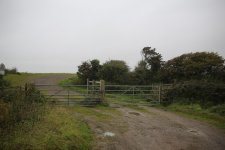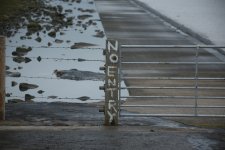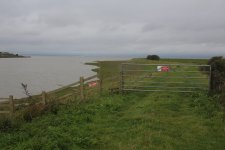Andrew Clarke
Well-known member
The thread on the Norfolk Pallas's Grasshopper twitch/debacle in the Rare Bird Information forum has got me wondering what can be done to improve and strengthen the relationship between birders and the local patches which they visit. I'd appreciate any help with this as it sounds like it's sorely needed in many areas, and not just at Holkham. Moderators, I did consider posting this in the 'Local Patch' forum but there is no space there to discuss the whole concept just sub-sections for individual regions so hope it's ok here.
Landowners & Access
Firstly, I wonder how many people realise what a big undertaking it can be to find an area to bird regularly and build a good relationship with the people who live and work there? One bad experience (e.g. with a bunch of rabid inconsiderate trespassing twitchers) can destroy years of hard work so it makes sense to be a good example and rather than all of us being tarred with the same brush.
I live in the sticks where much of the land away from the wild coast is private farmland. If I don't bump into a farmer on the lanes, my first port of call is the farmhouse where I introduce myself, explain my interest in birds and other wildlife and enquire about the possibility of being allowed to access all or part of their farm. Most farmers I meet are more than willing to let me roam around. I always mention that I will help where I can by highlighting any problems I encounter (see below) and have good relations with the landowners where I live (e.g. Mr Jones at Farm x etc) and more often than not you'll discover that they're related/friends or foe!
I often make a follow up visit to let the host know what I've seen and express my thanks for permission to roam. If necessary, I carry a large scale map on which I can mark access routes, habitat features etc and any badger setts, nest sites et al which the farmer knows about. Although some are ignorant of the wildlife on their Patch many are delighted to share their knowledge.
Bear in mind that there can be very good reasons why access might be denied. Some are suspicious of strangers. The funniest one I recall was where one bloke told me his father had said "never trust a man with a beard!!!" although having realised I was harmless he did allow me to walk his bleak pasture monoculture to look for breeding waders for a BTO survey, although I knew from a local elder that the Lapwings, Snipe and Curlews had departed decades ago as the wetland was drained and the silage cut became earlier each season.
Many of the local farmers are also shooters and obviously don't want members of the public around on a Saturday morning when they're blasting clay or real pigeons. Although you may disagree with hunting, the patches of 'wild bird cover crops' they sow in small fields for the Pheasants and partridges are absolutely fantastic for a range of declining species.
I was once helping a friend with a visit to monitor known Barn Owl sites. As we arrived at each house/farm we introduced ourselves and asked if the owls were about and whether we could have a look in the buildings for signs of activity such as feathers and pellets. Everyone was very welcoming, especially when we mentioned just how many rodents the owls each and the promise of nest box(s) in their barns or woods if they would like them. At one site there was no response from the farmhouse so we drove a few hundred metres down a track to the outlying barn where birds had bred before. Within minutes a 4 x 4 arrived at top speed and a load of large, red-faced young farmers jumped out. What the f**k where we up to!? We politely explained that we weren't about to steal their 50 gran Massey Fergusons but were there for the owl survey and they soon cooled down. I think wearing a birding t-shirt that day helped!
Security
As mentioned previously, bear in mind that there's a lot of rural crime with scumbag thieves targeting scrap, vehicles and even livestock and these places are literally the farmers' breadbasket so any assistance with keeping an eye on dodgy activity (e.g. keeping a note of suspicious car number plates) is much appreciated.
Livestock
I make a point that if I am allowed access I will endeavour to keep an eye on any problems such as injured animals like hobbling sheep or those with their head trapped in fencing, cows going into labour, damaged fences, gates that are left open etc. Exchange contact details with them. I've had to make a fair few few calls over the years to let them know that there's a herd of sheep lost in the road or the bullocks are chasing each other down the lane. These animals are bloody expensive and loosing just one can have a major impact on their livelihood.
And there's always a chance that you'll receive a call asking what that funny bird in the meadow is. I had a perfect description of a harrier species once from one bloke, which I didn't manage to relocate but was probably just a Pallid' knowing my luck.
Habitat creation
I hear talk of intrepid birders disseminating advice on habitat management for wildlife establishing feeding stations, planting trees and even digging scrapes, of which I am unashamedly jealous, I would absolutely love some freshwater on patch!
Nest boxes
Barn Owl nest boxes are a big hit with many farmers when you mention just how many rodents they take each year. Get the local ringing group involved and disseminate the news about how the birds are doing.
I also know of several places where ringers work hard to install and monitor boxes for species like Pied Flycatcher.
Sightings
Whether it's a public nature reserve or private farmland I find that everybody really appreciates being informed of your sightings. It's amazing how many members of the public literally have no idea what's on their doorstep and how excited they are when you tell them.
A blog or twitter account is very useful in this respect plus a print out of sightings of what you've had on their property.
I also hear positive things about the 'Patchwork Challenge' experience.
Public Events & Interpretation
OK so I'm veering a little off topic in part here but bear with me and maybe instigate/support some of the following where you live. Arranging and/or participating in public events in the community can be great fun. I'm thinking of indoor lectures and outdoor activities such as guided walks, Seawatch sessions, Picnic with a Porpoise events and we had a day with scopes set up looking at the roadside Grey Heronry at Pont Solomon in Pwllheli with guided walks to the adjacent harbour. Amazing response from members of the public young and old!
I've also produced a few Guided walks booklets in conjunction with the National Trust and North Wales Wildlife Trust.
I mentioned the Barn Owl monitoring earlier. We distributed copies of a bi-lingual North Wales Barn Owl newsletter that gave an overview of the whole project and was well received by the farming community et al.
Livelihood
Increasingly, landowners are realising the value of nature. Enhancing the visitor experience of those with holiday lets by sending a list of species to be seen is one idea. I've even mentioned the major impact that rarities can have by extending the tourist season on places like Scilly or Shetland.
Good relations
It's always worth sending landowners a Christmas card and/or gift like a local avifauna or framed photo taken at their place if you can manage it. Many people in rural communities are isolated and lonely and a friendly gesture with goodwill intended is really appreciated.
Any other thoughts, ideas or advice would be great.
Good Birding
Andrew
Landowners & Access
Firstly, I wonder how many people realise what a big undertaking it can be to find an area to bird regularly and build a good relationship with the people who live and work there? One bad experience (e.g. with a bunch of rabid inconsiderate trespassing twitchers) can destroy years of hard work so it makes sense to be a good example and rather than all of us being tarred with the same brush.
I live in the sticks where much of the land away from the wild coast is private farmland. If I don't bump into a farmer on the lanes, my first port of call is the farmhouse where I introduce myself, explain my interest in birds and other wildlife and enquire about the possibility of being allowed to access all or part of their farm. Most farmers I meet are more than willing to let me roam around. I always mention that I will help where I can by highlighting any problems I encounter (see below) and have good relations with the landowners where I live (e.g. Mr Jones at Farm x etc) and more often than not you'll discover that they're related/friends or foe!
I often make a follow up visit to let the host know what I've seen and express my thanks for permission to roam. If necessary, I carry a large scale map on which I can mark access routes, habitat features etc and any badger setts, nest sites et al which the farmer knows about. Although some are ignorant of the wildlife on their Patch many are delighted to share their knowledge.
Bear in mind that there can be very good reasons why access might be denied. Some are suspicious of strangers. The funniest one I recall was where one bloke told me his father had said "never trust a man with a beard!!!" although having realised I was harmless he did allow me to walk his bleak pasture monoculture to look for breeding waders for a BTO survey, although I knew from a local elder that the Lapwings, Snipe and Curlews had departed decades ago as the wetland was drained and the silage cut became earlier each season.
Many of the local farmers are also shooters and obviously don't want members of the public around on a Saturday morning when they're blasting clay or real pigeons. Although you may disagree with hunting, the patches of 'wild bird cover crops' they sow in small fields for the Pheasants and partridges are absolutely fantastic for a range of declining species.
I was once helping a friend with a visit to monitor known Barn Owl sites. As we arrived at each house/farm we introduced ourselves and asked if the owls were about and whether we could have a look in the buildings for signs of activity such as feathers and pellets. Everyone was very welcoming, especially when we mentioned just how many rodents the owls each and the promise of nest box(s) in their barns or woods if they would like them. At one site there was no response from the farmhouse so we drove a few hundred metres down a track to the outlying barn where birds had bred before. Within minutes a 4 x 4 arrived at top speed and a load of large, red-faced young farmers jumped out. What the f**k where we up to!? We politely explained that we weren't about to steal their 50 gran Massey Fergusons but were there for the owl survey and they soon cooled down. I think wearing a birding t-shirt that day helped!
Security
As mentioned previously, bear in mind that there's a lot of rural crime with scumbag thieves targeting scrap, vehicles and even livestock and these places are literally the farmers' breadbasket so any assistance with keeping an eye on dodgy activity (e.g. keeping a note of suspicious car number plates) is much appreciated.
Livestock
I make a point that if I am allowed access I will endeavour to keep an eye on any problems such as injured animals like hobbling sheep or those with their head trapped in fencing, cows going into labour, damaged fences, gates that are left open etc. Exchange contact details with them. I've had to make a fair few few calls over the years to let them know that there's a herd of sheep lost in the road or the bullocks are chasing each other down the lane. These animals are bloody expensive and loosing just one can have a major impact on their livelihood.
And there's always a chance that you'll receive a call asking what that funny bird in the meadow is. I had a perfect description of a harrier species once from one bloke, which I didn't manage to relocate but was probably just a Pallid' knowing my luck.
Habitat creation
I hear talk of intrepid birders disseminating advice on habitat management for wildlife establishing feeding stations, planting trees and even digging scrapes, of which I am unashamedly jealous, I would absolutely love some freshwater on patch!
Nest boxes
Barn Owl nest boxes are a big hit with many farmers when you mention just how many rodents they take each year. Get the local ringing group involved and disseminate the news about how the birds are doing.
I also know of several places where ringers work hard to install and monitor boxes for species like Pied Flycatcher.
Sightings
Whether it's a public nature reserve or private farmland I find that everybody really appreciates being informed of your sightings. It's amazing how many members of the public literally have no idea what's on their doorstep and how excited they are when you tell them.
A blog or twitter account is very useful in this respect plus a print out of sightings of what you've had on their property.
I also hear positive things about the 'Patchwork Challenge' experience.
Public Events & Interpretation
OK so I'm veering a little off topic in part here but bear with me and maybe instigate/support some of the following where you live. Arranging and/or participating in public events in the community can be great fun. I'm thinking of indoor lectures and outdoor activities such as guided walks, Seawatch sessions, Picnic with a Porpoise events and we had a day with scopes set up looking at the roadside Grey Heronry at Pont Solomon in Pwllheli with guided walks to the adjacent harbour. Amazing response from members of the public young and old!
I've also produced a few Guided walks booklets in conjunction with the National Trust and North Wales Wildlife Trust.
I mentioned the Barn Owl monitoring earlier. We distributed copies of a bi-lingual North Wales Barn Owl newsletter that gave an overview of the whole project and was well received by the farming community et al.
Livelihood
Increasingly, landowners are realising the value of nature. Enhancing the visitor experience of those with holiday lets by sending a list of species to be seen is one idea. I've even mentioned the major impact that rarities can have by extending the tourist season on places like Scilly or Shetland.
Good relations
It's always worth sending landowners a Christmas card and/or gift like a local avifauna or framed photo taken at their place if you can manage it. Many people in rural communities are isolated and lonely and a friendly gesture with goodwill intended is really appreciated.
Any other thoughts, ideas or advice would be great.
Good Birding
Andrew
Last edited:






